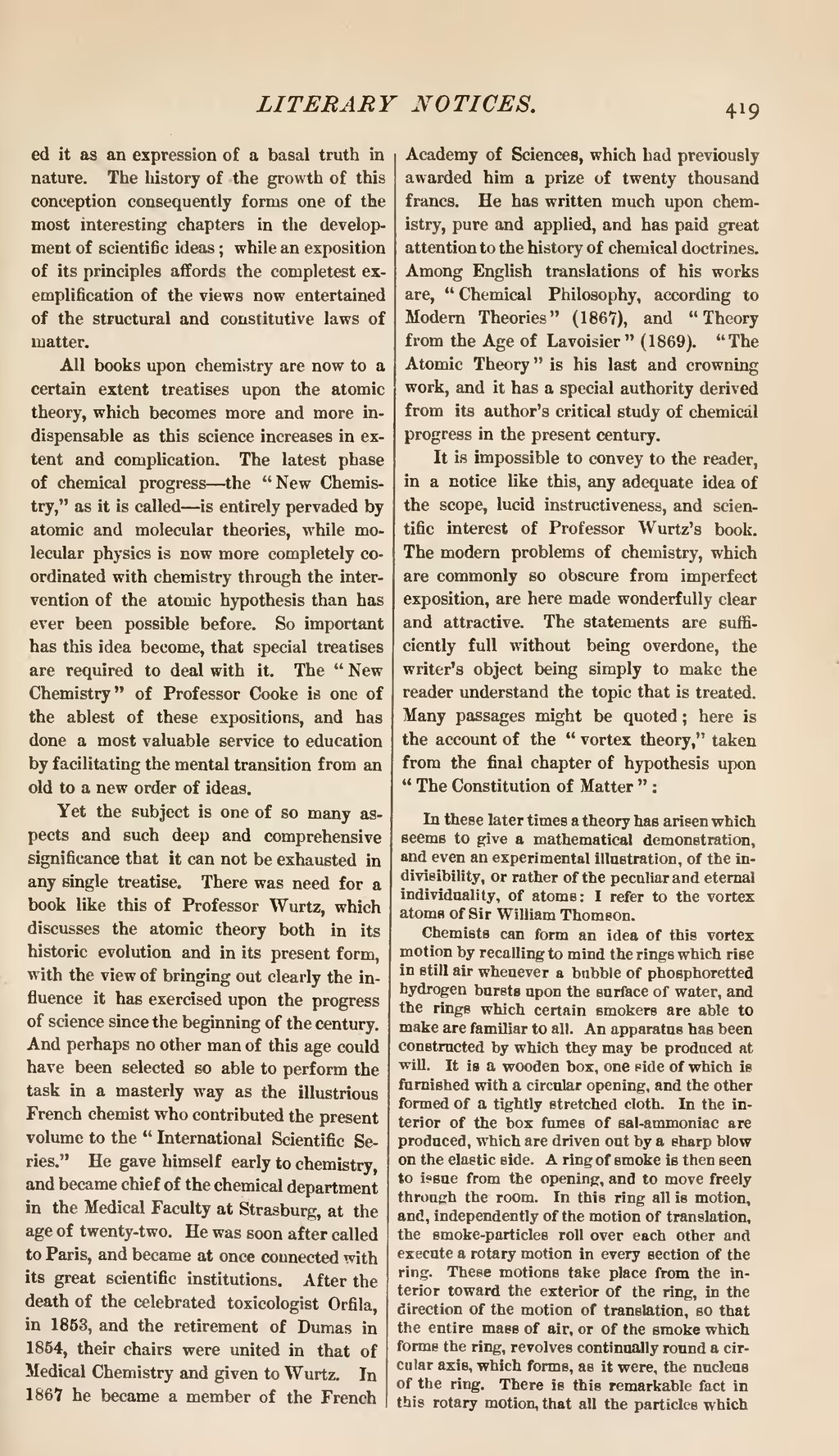ed it as an expression of a basal truth in nature. The history of the growth of this conception consequently forms one of the most interesting chapters in the development of scientific ideas; while an exposition of its principles affords the completest exemplification of the views now entertained of the structural and constitutive laws of matter.
All books upon chemistry are now to a certain extent treatises upon the atomic theory, which becomes more and more indispensable as this science increases in extent and complication. The latest phase of chemical progress—the "New Chemistry," as it is called—is entirely pervaded by atomic and molecular theories, while molecular physics is now more completely coordinated with chemistry through the intervention of the atomic hypothesis than has ever been possible before. So important has this idea become, that special treatises are required to deal with it. The "New Chemistry" of Professor Cooke is one of the ablest of these expositions, and has done a most valuable service to education by facilitating the mental transition from an old to a new order of ideas.
Yet the subject is one of so many aspects and such deep and comprehensive significance that it can not be exhausted in any single treatise. There was need for a book like this of Professor Wurtz, which discusses the atomic theory both in its historic evolution and in its present form, with the view of bringing out clearly the influence it has exercised upon the progress of science since the beginning of the century. And perhaps no other man of this age could have been selected so able to perform the task in a masterly way as the illustrious French chemist who contributed the present volume to the "International Scientific Series." He gave himself early to chemistry, and became chief of the chemical department in the Medical Faculty at Strasburg, at the age of twenty-two. He was soon after called to Paris, and became at once connected with its great scientific institutions. After the death of the celebrated toxicologist Orfila, in 1853, and the retirement of Dumas in 1854, their chairs were united in that of Medical Chemistry and given to Wurtz. In 1867 he became a member of the French Academy of Sciences, which had previously awarded him a prize of twenty thousand francs. He has written much upon chemistry, pure and applied, and has paid great attention to the history of chemical doctrines. Among English translations of his works are, "Chemical Philosophy, according to Modern Theories" (1867), and "Theory from the Age of Lavoisier" (1869). "The Atomic Theory" is his last and crowning work, and it has a special authority derived from its author's critical study of chemical progress in the present century.
It is impossible to convey to the reader, in a notice like this, any adequate idea of the scope, lucid instructiveness, and scientific interest of Professor Wurtz's book. The modern problems of chemistry, which are commonly so obscure from imperfect exposition, are here made wonderfully clear and attractive. The statements are sufficiently full without being overdone, the writer's object being simply to make the reader understand the topic that is treated. Many passages might be quoted; here is the account of the "vortex theory," taken from the final chapter of hypothesis upon "The Constitution of Matter":
In these later times a theory has arisen which seems to give a mathematical demonstration, and even an experimental illustration, of the indivisibility, or rather of the peculiar and eternal individuality, of atoms: I refer to the vortex atoms of Sir William Thomson.
Chemists can form an idea of this vortex motion by recalling to mind the rings which rise in still air whenever a bubble of phosphoretted hydrogen bursts upon the surface of water, and the rings which certain smokers are able to make are familiar to all. An apparatus has been constructed by which they may be produced at will. It is a wooden box, one side of which is furnished with a circular opening, and the other formed of a tightly stretched cloth. In the interior of the box fumes of sal-ammoniac are produced, which are driven out by a sharp blow on the elastic side. A ring of smoke is then seen to issue from the opening, and to move freely through the room. In this ring all is motion, and, independently of the motion of translation, the smoke-particles roll over each other and execute a rotary motion in every section of the ring. These motions take place from the interior toward the exterior of the ring, in the direction of the motion of translation, so that the entire mass of air, or of the smoke which forms the ring, revolves continually round a circular axis, which forms, as it were, the nucleus of the ring. There is this remarkable fact in this rotary motion, that all the particles which